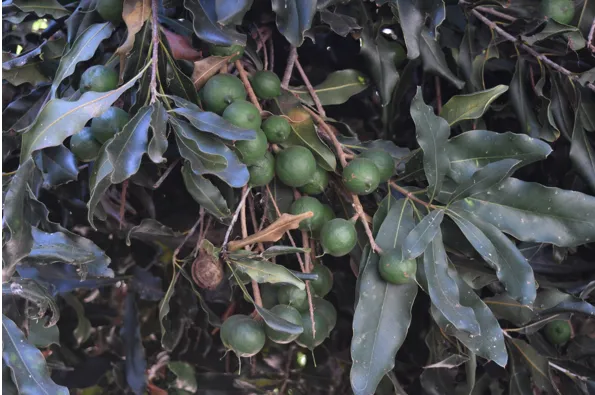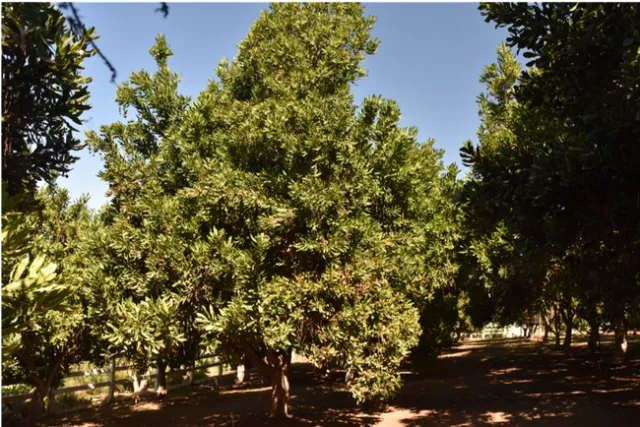
Most of the nut acreage in California can be found in the Central Valley. There you can find almonds, pistachio, pecans, and walnuts, however what you won't find is the macadamia tree. The macadamia tree can be found in high humidity subtropical climates such as coastal Southern California and some parts of the central coast. The bulk of the macadamias that are grown in California are grown in the San Diego County area. Most of the crop gets sold at farmers markets and other local venues, and through a small cooperative, the Gold Crown Macadamia Association. Macadamia nuts have the hardest shells to crack of the California nuts. The process of cracking the nuts also makes them a rare and expensive treat. The macadamia nut tree is a medium-sized evergreen tree with heavy, dark green foliage that is native to Australia. Hawaii is the leading macadamia-producing state in the US, and major global competitors for macadamias include Kenya, Costa Rica, South Africa and Australia.
Macadamias are in the Proteaceae family, and the two species which are grown are Macadamia integrifolia andM. tetraphylla. The tetraphylla species is thought to be more tolerant of cold temperatures and is primarily grown in California. The integrifolia species is more suitable for tropical countries and is grown in Hawaii for their macadamia industry.
California History
In 1879 Professor C. H. Dwinelle of the University of California, Berkeley obtained seeds of M. integrifolia in Australia and planted the first known trees in the state along a creek in Berkeley. However, it wasn't until around 1910 that 2 nurserymen in Southern California, Ernest Braunton and Charles Knowlton placed the first macadamia seedling tree, a tetraphylla selection for sale. Though trees had been sold in Southern California for a few decades, it wasn't until
1946 that Wells W. Miller and Vernon A. Nuthall founded the M and N Nursery in Vista, CA and became the first to specialize in and promote the macadamia as a replacement for avocados that had died on phytophthora root-rot infested lands. Currently, the California macadamia industry has 3 major varieties that are used, ‘Cate' (M. tetraphylla), ‘Beaumont' (a hybrid between M. tetraphylla andM. integrifolia) and ‘Vista' (a hybrid).
Biology
For commercial production the trees are propagated by grafting. Macadamias are a long-term crop taking an average four to five years from planting before cropping commences, seven years before commercially viable yields are produced and 10 to 12 years before breakeven. However, they have been known to live up to and keep producing up to 100 years old. The trees are evergreen and everbearing; they have leathery leaves much like holly that are shiny and 7-12 in long. Integrifolia leaves are smooth sided and the tetraphylla leaves are somewhat spiny along the edges. The trees themselves can grow up to as much as 60 ft high in the tropics, but usually about 25-30 ft high in California. Many of the selections are alternate-bearing, meaning alternate years produce light then heavy crops from a single tree. The ‘Cate' variety does not show very much alternate bearing and is the preferred variety in California.
They produce clusters of flowers (known as racemes) that are white or pink; about 300-600 flowers appear in sprays. The flowers are perfect but incomplete, they lack petals. The flowering of the trees occurs over a four to six-month period. The trees have bee-pollinated flowers, so beehives are usually imported into the orchards. Each flower spray produces up to 20 nuts, which have green, fibrous husks and hard, outer shells called pericarps. The shells do not split in the tetraphylla selections on the tree, but sometimes split as the nuts ripen on the trees in the some of the hybrid selections. Each nut (including the kernel in its shell) is approximately ½ in to 1 in. in diameter. The nuts mature at different times over the course of the year but most of the crop in California will fall to ground from late fall through spring. It is recommended to collect the nuts from the ground because shaking the trees will knock down immature nuts.

Common Cultivation Practices
Macadamia trees require rich soil, about 50 in of rain per year (in the tropics) or supplemental irrigation in California (about equal to an avocado tree) and temperatures that are not only frost-free but that vary within a limited range. The soil must also drain well as the trees do not do well in clay soils as the trees' tap roots cannot survive in such heavy soils (most of the tree roots are located on the top 3 feet of the soil line). Most growers use drip systems or micro-sprinklers in their orchards to conserve water. It is highly recommended to use mulch to reduce water loss and tensiometers or other types of moisture-monitoring equipment will be helpful with irrigation management. The ideal soil pH for macadamias is 6 to 6.5. To raise pH levels, one would add either lime, wood ashes, organic matter, or seaweed. If pH levels are too alkaline, growers will add sulfur, or peat moss and run acid fertilizer.
As mentioned, ripened and un-ripened nuts look identical, so growers usually wait until the nuts fall to the ground and harvest multiple times a season. The nuts are harvested through a complicated process that includes clearing weeds and debris from underneath the trees, gathering by hand or picking them with a mechanical picker (including golf-ball retrievers). In Hawaii, blowers are sometimes used to blow the nuts and fallen leaves into windrows so they can be collected by machine, but this can seldom be done in California due to the hilly terrain. Nuts are immediately run through a de-husking machine and then air dried on racks for two to three weeks. The drying is necessary to prevent mildew and rot. Heat drying is then usually done to finish the process. This could be done at temperatures of 95 to 110 degrees for about 2 to 5 days. The nuts are then packed in heavy plastic bags for storage and shipping.

Pests
Macadamias are susceptible to vertebrate pests such as squirrels, gophers, and rats. Squirrels and rats can cause erosion and damage the developing macadamia nut. Gophers will chew on the roots, weakening them making it to susceptible to root rots. Traps seem to be the most commonly used practice in the industry.
Stink bugs and navel orange worms (NOW) are considered moderate pests of macadamias but usually not to the point where treatment has to occur. Navel orange worms can be quite a challenge to control because the larvae live inside and cause damage in the growing nut making it difficult for pesticide application. Green stink bugs can also cause havoc in a macadamia orchard. They use their stylet to pierce through the nut causing mold and pathogens to reproduce, resulting in a discolored ruined nut. Stink bug damage can be reduced by removing compost piles away from the orchard, they use these piles for reproduction and shelter.
Besides being a tasty treat macadamia nuts are an excellent source of iron, calcium, vitamin B, and phosphorus. Although they contain 73-80% fat, the fat is monosaturated or "good" and as acceptable as olive oil in many diets. So, the demand for local macadamias is at an all-time high. However, macadamia production in California will continue to struggle and be threatened due to water and land prices in San Diego County. They are a labor-intensive commodity and will take many years for growers to get a return profit. In our experience, California macadamias growers seem to enjoy growing their nuts and despite the slim profits look forward to working the farmer's markets and the companionship of the other farmers and their customers.
Work Cited
Amy E. Griel, Yumei Cao, Deborah D. Bagshaw, Amy M. Cifelli, Bruce Holub, Penny M. Kris-Etherton. 2008.A Macadamia Nut-Rich Diet Reduces Total and LDL-Cholesterol in Mildly Hypercholesterolemic Men and Women, The Journal of Nutrition, Volume 138, Issue 4, April 2008, Pages 761–767, https://doi.org/10.1093/jn/138.4.761.
E. A. S. La Croix & H. Z. Thindwa.1986. Macadamia pests in Malawi. III. The major pests. The biology of bugs and borers, Tropical Pest Management, 32:1, 11-20, DOI: 10.1080/09670878609371019.
K. L. Kamminga, A. L. Koppel, D. A. Herbert, T. P. Kuhar. 2012. Biology and Management of the Green Stink Bug, Journal of Integrated Pest Management, Volume 3, Issue 3, 1 September 2012, Pages C1–C8, https://doi.org/10.1603/IPM12006.
R. E. Rice. 1978. Navel Orangeworm: a Pest of Pistachio Nuts in California, Journal of Economic Entomology, Volume 71, Issue 5, 15 October 1978, Pages 822 824, https://doi.org/10.1093/jee/71.5.822.
Shigeura, G. T., & Ooka, H. 1984. Macadamia nuts in Hawaii, history and production (No. 04; USDA, S481 S4.). Hawaii Institute of Tropical Agriculture and Human Resources, College of Tropical Agriculture and Human Resources, University of Hawaii at Manoa.

